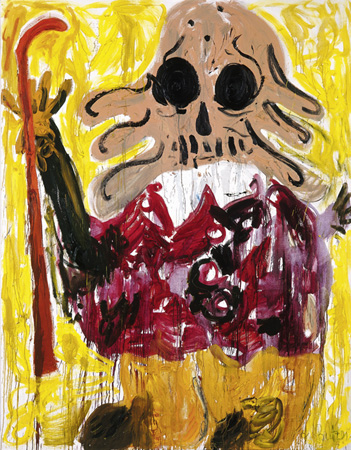| André Butzer |
|
-> further Works in the Exhibition Thomas Groetz Childish Defiance in an Empty World: On the Painting of André ButzerAndré Butzer has been steadily developing his contribution to contemporary painting since the end of the 1990s. The multi-figure image stands prominently in the foreground of his interest. Figuration, or the dissolution of figuration in the image-space, has been his deepest painterly concern. The sketchiness of the figuration, the construction of the pictorial beings from comic-like features as well as their reduction to symbols, which can be but do not have to be read as abstractions, define the artist’s central occupation. Before a systematically applied typology of his beings can take hold, Butzer confronts the observer with colorful multi-figure pictures. In Helfet und viel Glück (2000), three to four figures combine in a semi-unrepresentational world of form and color. Their affixed or conjoined, body-like appearances are complemented by quasi-patterns of lineation and dotted areas. The surroundings, populated with figures, are perceptible, due to color streaks that act as shadows, and furthermore come into view as bubble-like protuberances out of the conglomeration of the figures. Butzer began in 2000 to develop a kind of genealogy of masculine figure types, to which he gave odd descriptions and names, among them the Friedens-Siemens type. Balloon-like heads, also appearing in Helfet und viel Glück, are identifiable, separated from their body structures, which completely fill the image-space. In Todall! (1) (2002/2003) such a type is shown with his oversized comic eyes and a line swaying below them, which can be decoded as a childishly self-satisfied, laughing mouth. Another kind of figure from this period is the so-called Schande-Mensch, a being that often waves to the observer with a maimed, phallic arm, although it is characterized as lifeless. His head is a smiling skull with black holes for eyes. A derivative of this type is the Wanderer, who also confronts us in Hölderlinapotheke (2003): he is equipped with hiking gear such as heavy boots and a curved hiking stick, ready for his journey. Where he is going is not clear: out of the realm of the dead or straight into it? André Butzer combines his various individual types into compositions with multiple figures. His series of paintings Hemmleben (2003) with its rapid-flowing, diluted and transparent-seeming oil paint on the floor appears as a kind of (Anti)-The Frieze of Life of our developmentally stagnate epoch: placed inside landscape-formatted filmstrips is a rendezvous of furiously gesticulating “men” in brown jackets, ingenuous or self-absorbed, smiling “women” and “child-like” cephalopods on stumpy legs with naive or dumb expressions. Their adding up of individual parts prevents, however, a real recognition. Each figure remains, for itself alone, in its grotesque, pseudo-naïve uniqueness, or exaggerated self-referentiality. Similar to André Butzer’s early figurative paintings , only the color fields suggest the image-space. In this context, the question arises as to whether André Butzer’s figures refer at all to human beings. Perhaps they do not exist in the artist’s principle visual cosmos; rather, they are only the variations of templates of imaginary creatures. Hands, often characterized by gloves, refer to the relationship with the realm of comics, especially the classical comic figures of Walt Disney. There, it was not about real beings, but rather the synthetic sprites from the industrial age between the two world wars, which have remained untouched by the cataclysmic events caused by these catastrophes, as well as the resulting moral decline. André Butzer takes up the artificial and grotesque element of the comic figure and realizes it in large format with brushes and oil paints in a new way, by heightening or exaggerating the effect. His Friedens-Siemenses are (like his other figures) bucolic, strongly hued, passionately expressive paintings arising from constructs. They correspond with lifeless, grotesque creatures, who demand sympathy with their big eyes, and seem to be bubbling over with affection as well as affliction. They are missing bones, a spine, composure (in the real and figurative sense); they seem like color-kneaded, balloon-shaped containers, which meanwhile have lost their air for lack of a real existence. [...] Catalog excerpt "Extended. Sammlung Landesbank Baden-Württemberg" Editors: Lutz Casper, Gregor Jansen, published by Kehrer Verlag Heidelberg, 2009 ^
|

